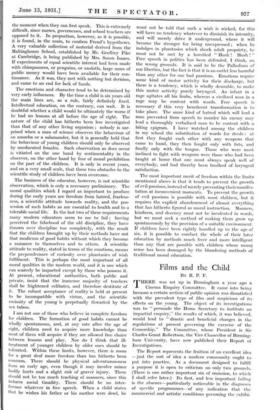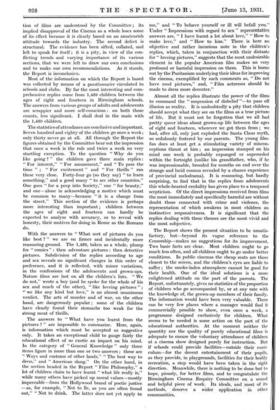Films and the Child BY R. P. F. T HERE was
set up in Birmingham a year ago a Cinema Enquiry Committee. It came into being because a certain section of public opinion was dissatisfied with the prevalent type of film and suspicious of its effects on the young. The object of its investigations was to " persuade the Home Secretary to institute an impartial enquiry," the results of which, it was believed, would lead to " drastic and beneficial changes in the regulations at present governing the exercise of the Censorship." The Committee, whose President is Sir Charles Grant Robertson, the Vice Chancellor of Birming- ham University, have now published their Report of Investigations.
The Report represents the fruition of an excellent idea —just the sort of idea a modern community ought to put into practice. As a document designed to fulfill a purpose it is open to criticism on only two grounds. (There is one rather important sin of omission, to which I shall refer later.) Its first, and less important failing is the absence—particularly noticeable in the diagnoses of specific programmes—of any indication that the commercial and artistic conditions governing the exhibi- tion of films are understood by the Committee ; its implied disapproval of the Cinema as a whole loses some of its effect because it is clearly based on an amateurish attitude towards the industry. The second defect is structural. The evidence has been sifted, collated, and left to speak for itself ; it is a pity, in view of the con- flicting trends and varying importance of its various sections, that we were left to draw our own conclusions and to make our own recommendations. As it stands, the Report is inconclusive.
Most of the information on which the Report is based was collected by means of a questionnaire circulated to schools and clubs. By far the most interesting and com- prehensive replies come from 1,439 children between the ages of eight and fourteen in Birmingham schools. The answers from various groups of adults and adolescents are scrappier and more self-conscious : on both those counts, less significant. I shall deal in the main with the 1,439 children.
The statistics of attendance are conclusive and important. Seven hundred and eighty of the children go once a week; only thirty never go at all. All through the Report the figures obtained by the Committee bear out the impression that once a week is the rule and twice a week no very startling exception. To the question " Why do you like going ? " the children gave three main replies : " For interest," " For amusement," and " To pass the time " ; " For excitement " and " For thrills " ran these very close. Forty-four go (so they say) " to learn something," and a good many " to see other countries." One goes " for a peep into Society," one " for beauty," and one—alone in acknowledging a motive which must be common to many—because " it is a change from the street." This section of the evidence is perhaps more interesting than important ; children between the ages of eight and fourteen can hardly be expected to analyse with accuracy, or to reveal with honesty, their motives for doing in Rome as the Romans do.
With the answers to " What sort of pictures do you like best ? " we are on firmer and incidentally more reassuring ground. The 1,439, taken as a whole, plump for " comics " : then adventure pictures : then detective pictures. Subdivision of the replies according to age and sex reveals no significant changes in this order of preference, and it is reflected, with minor variations, in the confessions of the adolescents and grown-ups. Nature films are last on all the children's lists. " We do not," wrote a boy (and he spoke for the whole of his sex and much of the other), " like loveing pictures " ; " we like any kind but love," is an almost unanimous verdict. The arts of murder and of war, on the other hand, are dangerously popular ; some of the children have clearly found their stomachs too weak for the strong meat of thrills.
The answers to " What have you learnt from the pictures ? " are impossible to summarize. Here, again, is information which must be accepted as suggestive only. It takes an exceptional child to gauge fairly the educational effect of so exotic an impact on his mind. In the category of " General Knowledge " only three items figure in more than one or two answers ; these are " Ways and customs of other lands," " The best way to dress," and " American slang." On the other hand, in the section headed in the Report " Film Philosophy," a lot of children claim to have learnt " what life really is," while many others have picked up moral values—mostly impeccable—from the Hollywood brand of poetic justice —as, for example, " Not to lie, as you are often found out," " Not to drink. The latter does not yet apply to me," and " To behave yourself or ill will befall you." Under " Impressions with regard to sex " representative answers are, " I have learnt a lot about love," " How to make love," and " How to kiss." There is here an objective and rather incurious note in the children's replies, which, taken in conjunction with their distaste for " loveing pictures,".suggests that the most undesirable element in the popular American film makes no very profound or harmful impression on them. This is borne out by the Puritanism underlying their ideas for improving the cinema, exemplified by such comments as, " Do not have rood pictures," and, " Film actresses should be made to dress more decenter."
Almost all the replies illustrate the power of the films to command the " suspension of disbelief "—to pass off illusion as reality. It is undoubtedly a pity that children should accept what they see on the films as a true picture of life. But it must not be forgotten that we all had pretty queer ideas about grown-up life between the ages of eight and fourteen, wherever we got them from ; we had, after all, only just exploded the Santa Claus myth, so sedulously fostered by our parents. The young film- fan does at least get a stimulating variety of miscon- ceptions thrust at him ; an impression stamped on his mind one week is probably expunged or superseded within the fortnight (unlike his grandfather, who, if he was impressionable, brooded for months on end over the strange and lurid cosmos revealed by a chance experience of provincial melodrama). It is reassuring, but hardly surprising, to find that in the replies from adolescents this whole-hearted credulity has given place to a tempered scepticism. Of the direct impressions received from films the most immediately and specifically harmful are without doubt those connected with crime and violence, the representation of which awakens in most children an instinctive responsiveness. It is significant that the replies dealing with these themes are the most vivid and the most subjective.
The Report shows the present situation to be unsatis- factory, but—beyond its vague reference to the Censorship—makes no suggestions for its improvement. Two basic facts are clear. Most children ought to go much less often, and all children ought to go under better conditions. In public cinemas the cheap seats are those closest to the screen, and the children's eyes are liable to suffer ; the smoke-laden atmosphere cannot be good for their health. One of the ideal solutions is a more enlightened attitude on the part of the parents. The Report, unfortunately, gives no statistics of the proportion of children who go accompanied by, or at any rate with the knowledge of, the grown-up members of their family. The information would have been very valuable. There can be very few places where a manager would find it commercially possible to show, even once a week, a programme designed exclusively for children. What seems to be needed is some action on the part of the educational authorities. At the moment neither the quantity nor the quality of purely educational films is adequate to ensure the voluntary attendance of children at a cinema show designed purely for instruction. But if schools could provide facilities—outside their curri- culum—for the decent entertainment of their pupils, as they provide, in playgrounds, facilities for their bodily recreation, a step would have been taken in the right direction. Meanwhile, there is nothing to be done but to hope, piously, for better films, and to congratulate the Birmingham Cinema Enquiry Committee on a sound and helpful piece of work. Its ideals, and most of its methods, deserve a wider application in other communities.







































 Previous page
Previous page